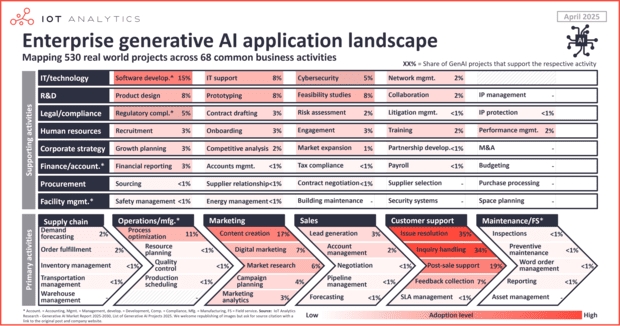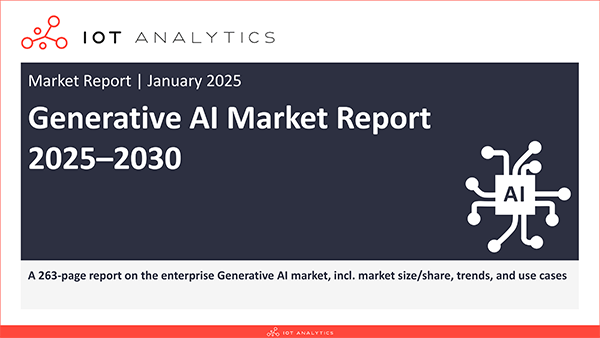The top 10 enterprise generative AI applications – Based on 530 real-world projects
作者: Joaquin Fernandez

In short
- Generative AI is used across departments. Most of the 530 identified generative AI implementations are in customer support, marketing, IT, operations, and R&D.
- Customer issue resolution is the top application. 49% of projects focus on customer support, with issue resolution alone making up 35%.
- Tech sector and North America lead adoption. 56% of projects were implemented inside tech companies, and 56% were implemented in North America.
Why it matters
- For generative AI vendors: It is important to focus on where generative AI initiatives are taking off and creating real value for customers.
- For generative AI adopters: Enterprises should look at generative AI applications to learn where they can add value and study which vendors may best support their needs.
The insights from this article are based on
List of Generative AI Projects 2025
A structured repository of 530 generative AI projects. Each entry includes a number of details about each individual project (e.g., the companies implementing the projects, project details, AI model vendors involved, specific business activities, departments impacted, and more).
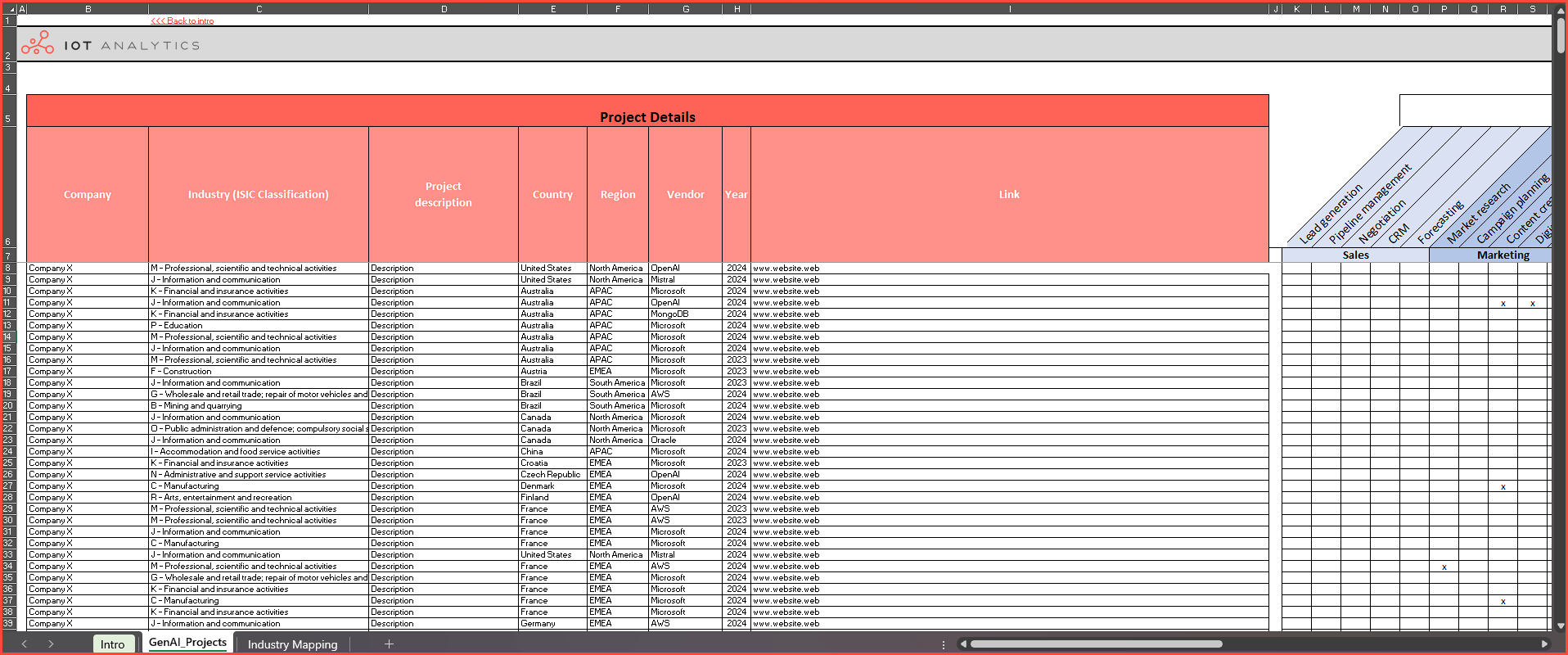
Already a subscriber? View your reports here →
The #1 business activity augmented by generative AI is customer issue resolution, appearing in 35% of the 530 enterprise generative AI projects that IoT Analytics identified and published in its List of Generative AI Projects (published February 2025). The list contains generative AI projects that enterprises implemented in 2022, 2023, or 2024—providing insights into how companies have applied generative AI into their operations—as part of IoT Analytics’ Generative AI Market Report 2025–2030 (published January 2025). The generative AI projects list includes a number of details about each individual project (e.g., the companies implementing the projects, project details, AI model vendors involved, the countries where implemented, the industry context, and, crucially, the specific business activities and departments impacted).
Additional overarching research findings from the list of 530 generative AI projects include:
- Generative AI is broadly applicable across departments. Every single one of the 14 different departments IoT Analytics looked at for its study has generative AI activity—across primary activities like operations or sales and secondary activities like HR or legal.
- #1 department to adopt generative AI: Customer support. Coinciding with customer issue resolution being the top business activity, 49% of projects were aimed at enhancing customer support functions overall. Other departments that are seemingly making heavy use of generative AI are marketing (27%) and IT (24%).
- #1 industry to adopt generative AI: Technology. The technology industry leads in adoption with 56% share of projects, with notable examples including SAP’s Joule AI assistant or Salesforce Einstein GPT. Many of the Generative AI projects implemented in the technology industry result in products that are then sold to other companies. Manufacturing (8%) is the second biggest industry. Notable examples of projects adopted within each industry are Siemens Industrial Copilot or Coca-Cola’s Coke Creations project. Professional services (7%) comes third with projects such as KPMG KymChat or Accenture AI Navigator.
- #1 region to adopt generative AI: North America. From a regional perspective, the data shows North American organizations are ahead in the adoption of generative AI, representing 56% of total activity. This is followed by companies based in the EMEA region (27%) and those in the APAC region (15%).
These are just a few high-level stats from the list of generative AI projects. Below, the IoT Analytics team dives deeper into the top 10 enterprise generative AI applications, ranked by frequency of adoption across the 530 projects. Each application represents a different business activity that benefits from generative AI.
Methodology
The IoT Analytics team performed an extensive internet search of publicly known generative AI projects between May 2022 and September 2024 and gathered all available information for each of the 530 identified case studies. In order for a project to be included in the list, the project had to focus on the use of generative AI, and sufficient information had to be available for proper classification and analysis.
Definition of generative AI
Generative AI is a type of artificial intelligence that leverages deep-learning techniques to generate new text, code, images, audio, video, or other forms of media. It relies on models that are trained to analyze the patterns and structures within large datasets and use that analysis to produce new outputs that share similar characteristics.
The top 10 generative AI applications

1. Issue resolution for customer support – 35% of projects
What it is
Issue resolution refers to handling inbound support tickets, complaints, or problems raised by customers with their products or services. Generative AI can automatically classify, route, and even respond to user issues—often across multiple languages and channels.
Business impact
Automating customer support with generative AI can help improve KPIs such as average resolution time, first contact resolution rate, customer satisfaction, and support cost per ticket. By reducing manual triage and enabling faster responses, enterprises report response time improvements by up to 80% while handling higher ticket volumes without proportional increases in staffing.
Additionally, AI-powered support can operate 24/7 and in multiple languages, enabling consistent service across regions and time zones. Over time, adopters hope that this leads to improved customer loyalty, reduced churn, and substantial cost savings—particularly for organizations with large-scale customer operations.
Example: Klarna’s AI service agent
In January 2024, Swedish fintech company Klarna deployed a generative AI-based customer service agent powered by OpenAI that reportedly resolved the equivalent workload of 700 support agents. Klarna’s agent now handles inquiries across 23 markets and, according to the company, delivers faster, round-the-clock support while also contributing to cost reductions and efficiency gains.
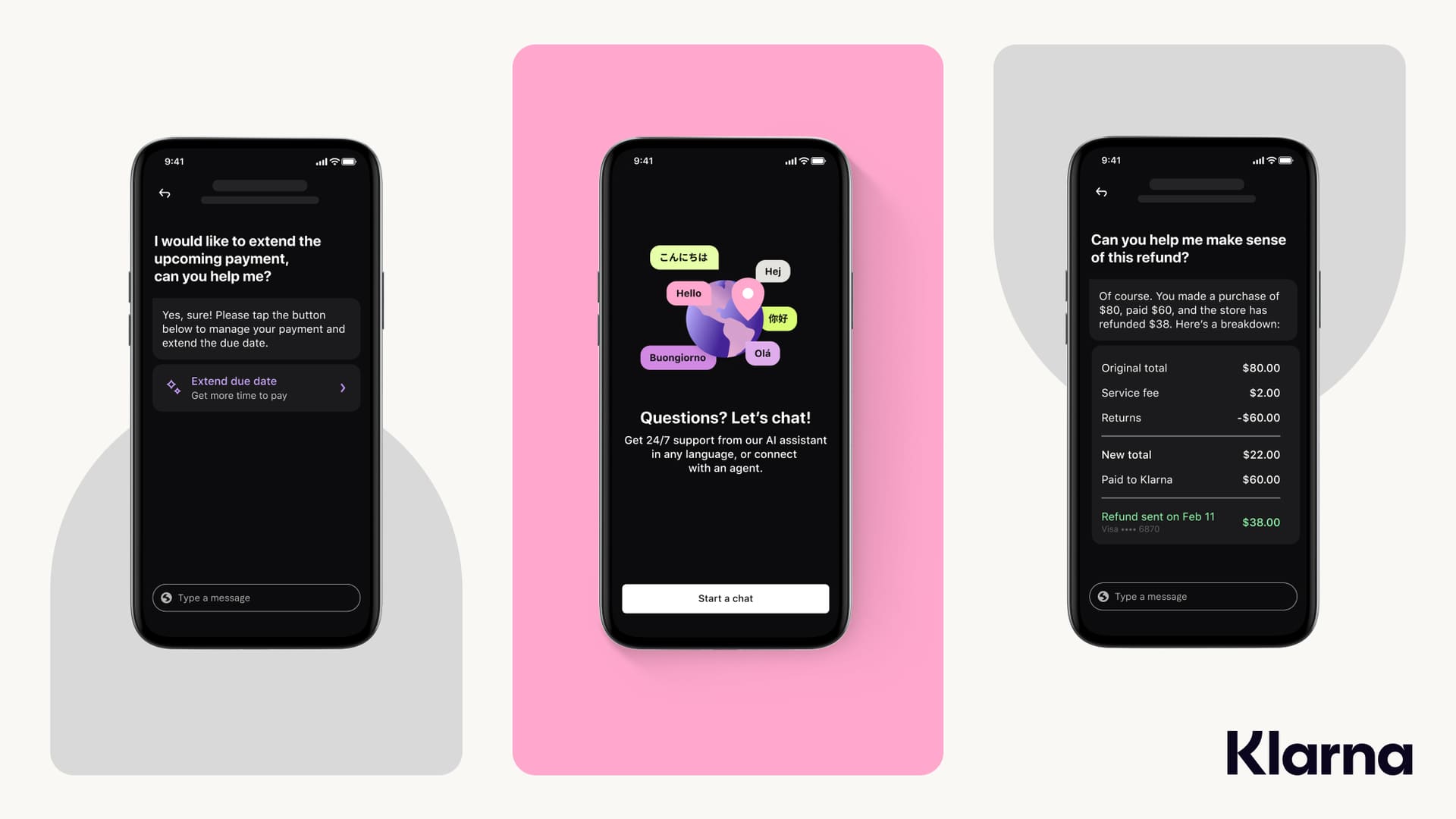
Klarna’s generative AI-based customer service agent is the company’s 24/7 customer support agent (source: Klarna)
2. Inquiry handling for customer support – 34% of projects
What it is
Inquiry handling involves responding to customer requests for information—such as requests for product information, pricing details, order status, or service explanations. Generative AI can automate these tasks, letting customer support agents focus on more urgent matters.
Business impact
By automating standard inquiries, companies can deflect tickets from live agents, freeing them to focus on more complex cases. This helps reduce response times, lower customer effort scores, and increase satisfaction. AI-driven responses can be tailored to the customer’s context (e.g., past orders), improving accuracy and perceived value.
Example: Kuka’s automated inquiry assistant
In April 2023, KUKA, a global automation solutions provider, worked with Empolis, a Germany-based AI software company, to develop the proof-of-concept for—and adopt—Empolis’ generative AI virtual assistant named Empolis Buddy. Built using AWS’ Amazon Bedrock, Empolis Buddy leverages large language models to access and query extensive documentation, including standard operating procedures and manufacturing manuals.
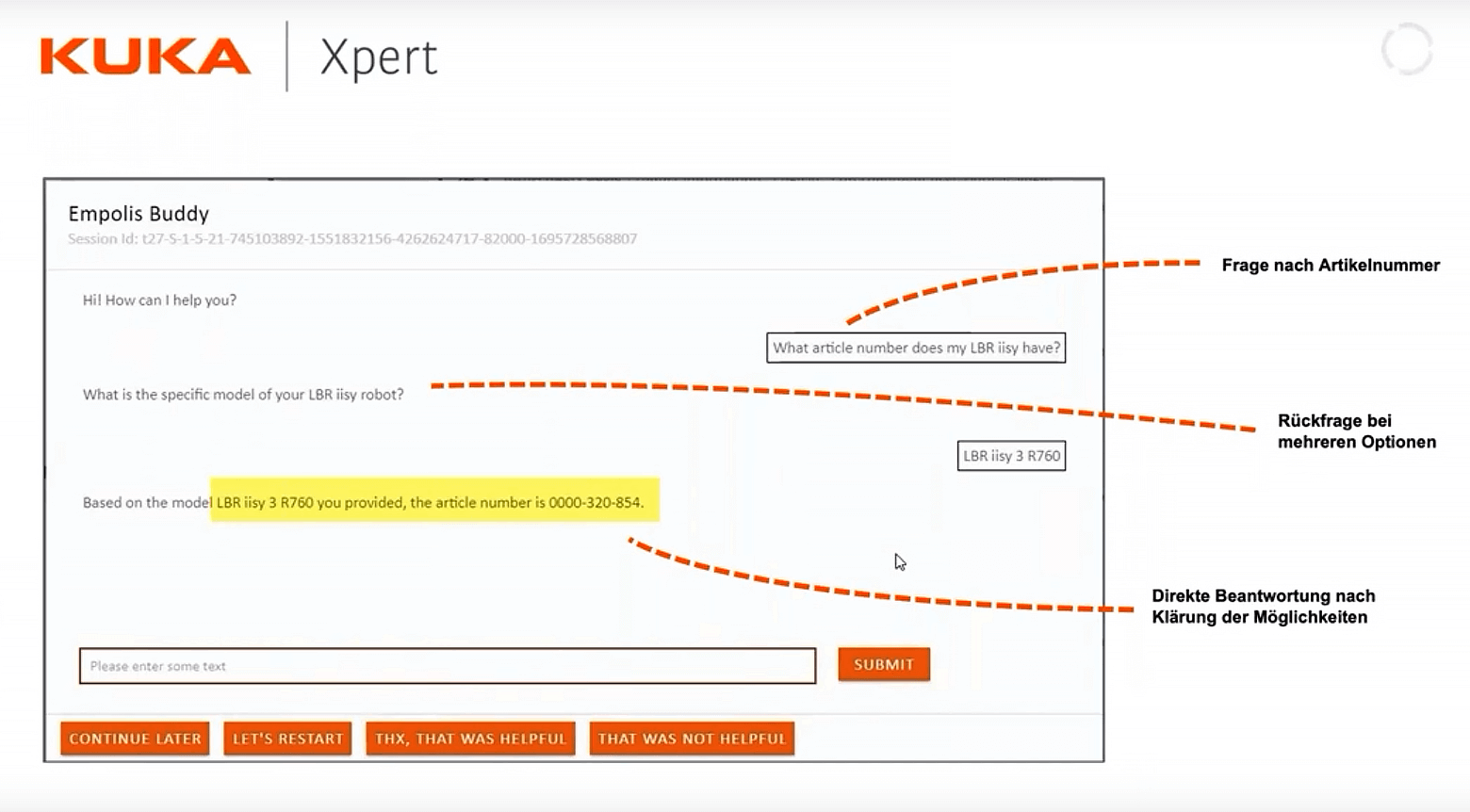
Empolis Buddy powers Kuka Xpert and lets customers inquire about specific product information such as “What article number does my LBR iisy have?” (source: Empolis-Kuka webinar)
3. Post-sale support for customer support – 19% of projects
What it is
Post-sale support encompasses tasks like onboarding assistance, product usage guidance, returns processing, and warranty management. Generative AI can be embedded into help centers, email responders, or IVR systems to guide customers after they have made a purchase.
Business impact
Enhancing post-sale experiences helps prevent churn and increases upsell opportunities. Generative AI supports a proactive service model—guiding users before issues arise, personalizing advice based on purchase history, and minimizing post-sale friction. This can reduce ticket volumes and improve net promoter scores (or NPS).
Example: Telstra’s AI assistant for service agents
In mid-2023, Telstra, an Australian telecom provider, developed two generative AI tools—Ask Telstra and One Sentence Summary—using Microsoft Azure OpenAI Service to enhance customer support after service activation. These tools help agents quickly access account and product details and summarize past interactions, enabling faster troubleshooting and more personalized follow-ups. According to Telstra, the tools reduced follow-up contacts by 20%, with 90% of its customer service employees reporting time savings and improved post-sale support quality.
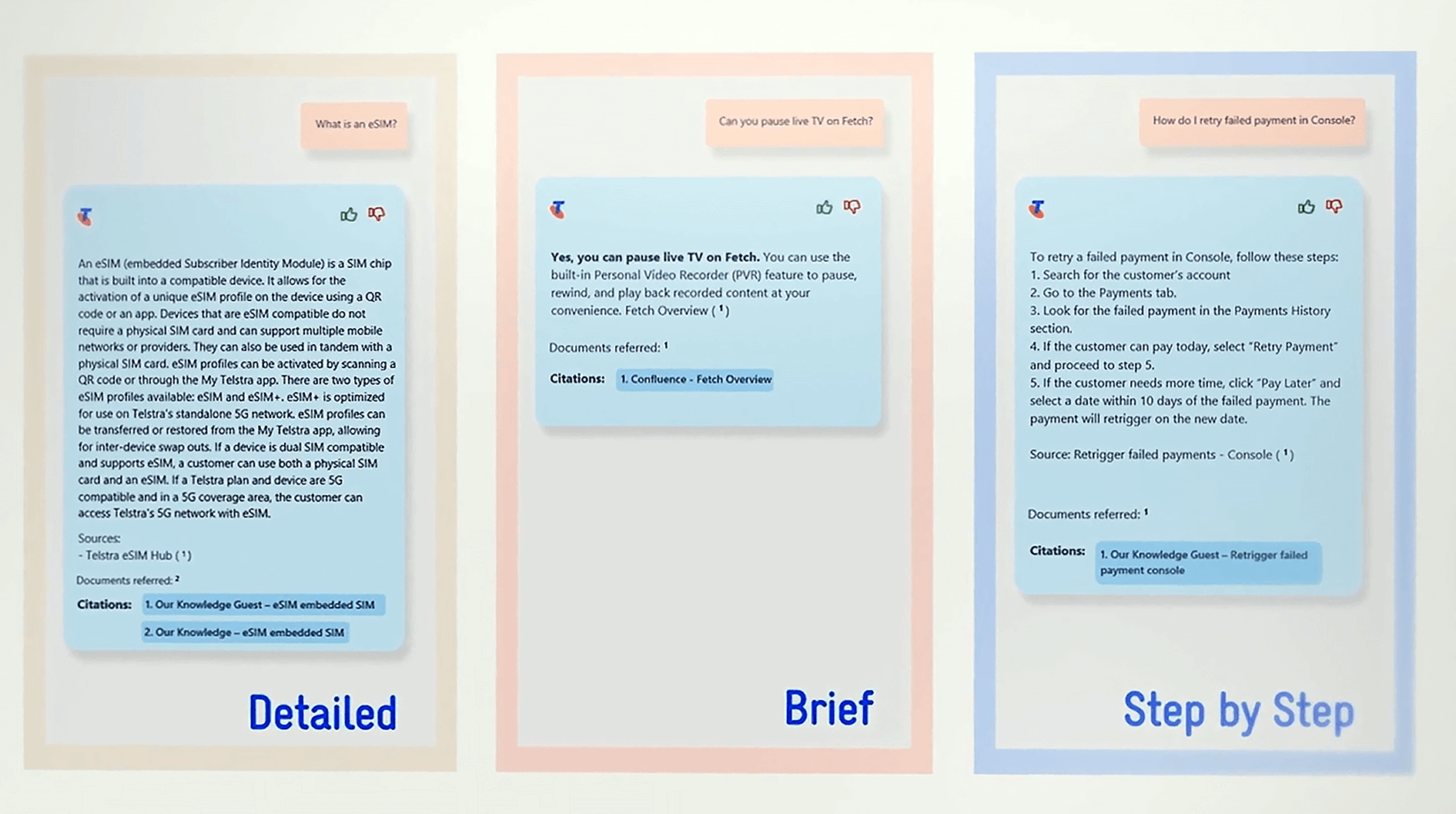
Ask Telstra, the company’s AI assistant for its own customer service, has three different modes: 1) detailed answers, 2) brief answers, and 3) step-by-step instructions (source: Microsoft)
4. Content creation for marketing – 17% of projects
What it is
Content creation refers to generating blogs, social media posts, ad copy, landing pages, email campaigns, and internal communications. Generative AI can create (or help create) this content, leveraging large language models that are fine-tuned for tone and subject matter relevance.
Business impact
AI can reduce time-to-market for campaigns and new content (e.g., webpages) by automating first drafts, tailoring messaging to audience segments, and ensuring brand consistency. It also reduces agency dependence and scales personalization efforts without requiring equivalent staff increases.
Example: NC Fusion’s marketing assistant
In mid-2023, NC Fusion, a nonprofit youth sports organization in North Carolina, adopted Microsoft Copilot within Dynamics 365 Customer Insights to enhance its targeted marketing campaigns, such as email and customer journey creation. Facing challenges in scaling personalized outreach due to limited resources, the organization utilized Copilot’s generative AI capabilities to streamline content creation and audience segmentation. This integration enabled NC Fusion to reduce email drafting time from 60 minutes to 10 minutes, facilitating quicker deployment of targeted campaigns like the “You do belong” initiative aimed at encouraging girls to remain engaged in sports. As a result, the organization reported a threefold increase in customer engagement, adding:
“We are a very small team, but need to show up like a pro sports organization, so enabling me to significantly reduce the time it takes me to create emails and journeys has been a big win. For a standard email, it might have taken me about one hour before; now it takes about 10 minutes.”
Chris Barnhart, head of IT and Data Systems at NC Fusion
5. Software development for IT – 15% of projects
What it is
Software development refers to code generation, debugging, code documentation, and test case creation for software. For assistance in these tasks, developers can use generative AI-based tools embedded into integrated development environments (IDEs), such as GitHub Copilot, Amazon Q Developer, and other proprietary copilots, or work with chatbots, like ChatGPT, Gemini, or Claude.
Business impact
AI support reduces time spent on boilerplate code, documentation, and maintenance tasks—enabling developers to focus on high-impact features. Organizations benefit from faster releases and fewer bugs in production.
Example: JetBrains’ AI Assistant integration for programming
JetBrains, a Czech programming tools provider based in the Netherlands, announced its AI Assistant for its suite of IDEs in June 2023. Using OpenAI’s API, this assistant aids developers by generating code snippets, suggesting refactorings, and providing explanations for code segments. According to JetBrains, the AI Assistant has become the company’s fastest-growing product, with 77% of developers reporting increased productivity and 55% noting more time to focus on engaging tasks. The integration has streamlined the development process, allowing for more efficient coding and problem-solving.
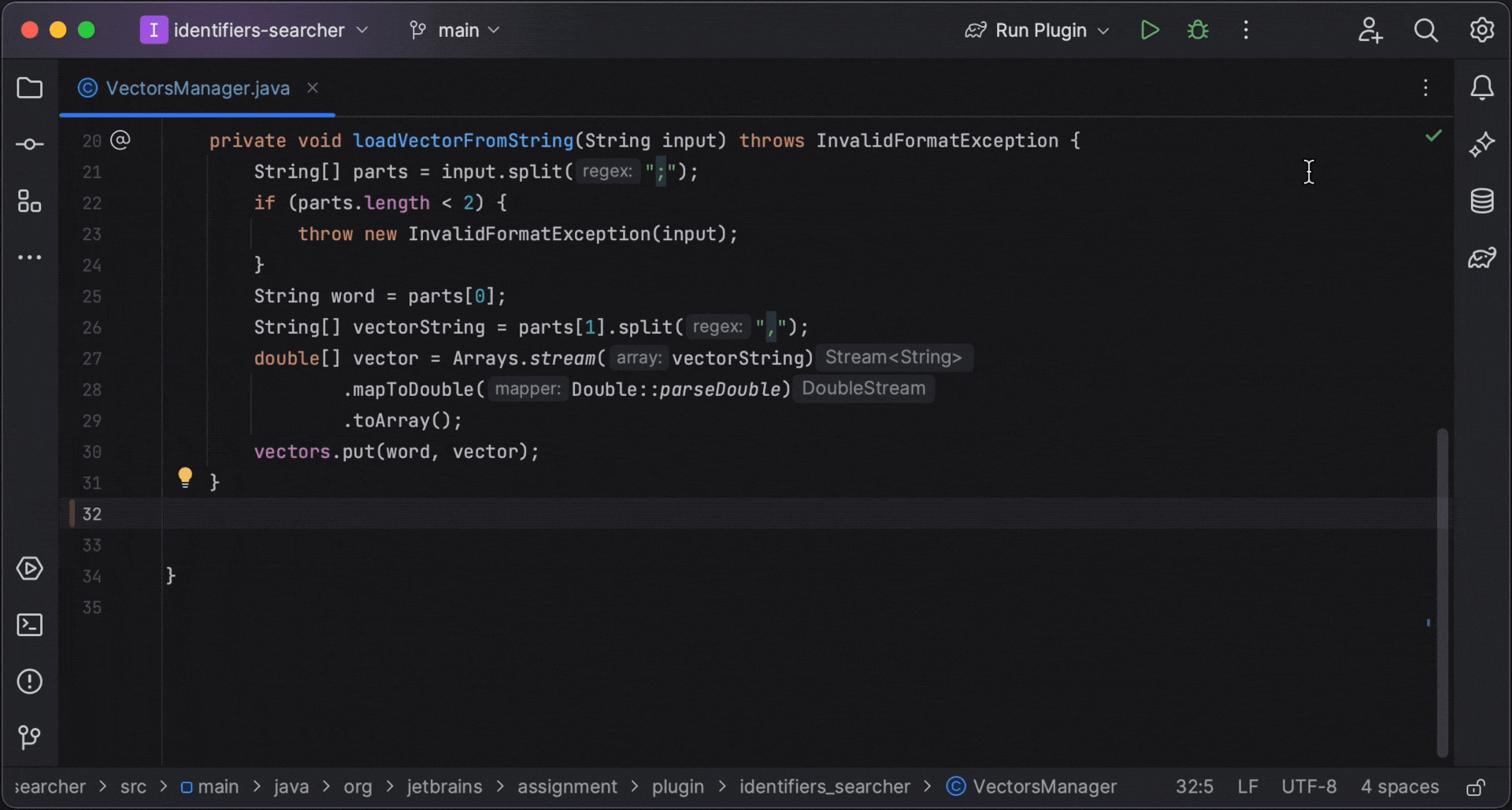
JetBrain’s AI Assistant drafts specific functions based on natural language input (source: JetBrains)
6. Process optimization for operations – 11% of projects
What it is
Process optimization involves improving business workflows to increase efficiency, reduce costs, and enhance output quality. In operations, this means streamlining tasks, eliminating bottlenecks, and standardizing procedures. Generative AI supports this by analyzing data (e.g., identifying delays in production logs) and generating recommendations or documentation (e.g., drafting updated SOPs for equipment handling)—helping teams identify improvements faster and implement them more effectively.
Business impact
Generative AI enables faster identification of inefficiencies and streamlines routine improvements, helping organizations cut operational costs, reduce manual effort, and accelerate implementation. By automating tasks like documentation and data analysis, companies can achieve more consistent performance and realize measurable gains in efficiency and ROI across their operations.
Example: Covered California’s document automation initiative
In April 2024, Covered California, a U.S.-based health insurance marketplace, implemented a generative AI-powered claims verification process using Google Cloud’s Document AI in collaboration with Deloitte. The AI now automates recurring manual tasks such as reviewing eligibility documents, extracting relevant data, and determining verification status. According to Covered California, this automation improved the document verification rate from 28–30% to 84%, with expectations to surpass 95% after additional training—leading to faster claim processing and enhanced customer service.
“No one wakes up on a Monday and says, ‘I can’t wait to manually verify 40 documents today.’ Automating this process elevates our employees to do more meaningful work, like having a conversation with someone about how their eligibility is determined or to explain the benefits of one plan versus another.”
Kevin Cornish, CIO of Covered California (source)
7. IT support – 8% of projects
What it is
IT support teams help with common technical issues such as password resets, software troubleshooting, and system access requests. These tasks can be left to generative AI so IT support teams can focus on achieving organizational IT goals. Generative AI-based tools are often embedded into enterprise help desks or virtual agents.
Business impact
By handling repetitive queries automatically, organizations can reduce ticket backlogs, lower support costs, and free up IT staff for higher-complexity tasks. AI can also deliver more consistent and accurate resolutions by drawing on structured documentation and historical cases.
Example: Condor’s AI-powered IT support assistant
In 2024, Condor, a Brazil-based consumer goods company, developed a generative AI prototype to enhance its internal IT support, collaborating with AWS partner MadeinWeb, reportedly built in just weeks. Condor adopted MadeinWeb’s generative AI platform Charla, which aims to help companies use Amazon Bedrock in cases such as virtual assistants. Condor’s AI assistant was trained on its historical IT tickets and technical documentation, and according to Condor, the assistant provides accurate, context-aware responses to employee inquiries, improving service desk efficiency and reducing response times.
8. Product design for R&D – 8% of projects
What it is
Product design is the ideation and development of new products. Generative AI can generate design variations, customize features, and create digital prototypes based on textual descriptions or reference images.
Business impact
By automating aspects of the design process, companies can explore a wider range of design options, tailor products to specific customer preferences, and streamline the transition from concept to production.
Example: Grid Dynamics’ Generative AI Product Design Starter Kit
In May 2023, Grid Dynamics, a U.S.-based digital engineering company, launched its Generative AI Product Design Starter Kit to support retailers, brands, and manufacturers in accelerating product design and digital experience development. The kit includes reference models and workflows that leverage text-to-image and image-to-image generative AI capabilities—enabling users to generate, edit, and restyle product concepts from textual prompts or existing visuals. According to Grid Dynamics, this approach enhances early-stage design ideation, shortens prototyping cycles, and supports more personalized product experiences at scale.

Example of Grid Dynamics’ Generative AI Product Design Starter Kit process flow. Left: Initial product ideation for a modern armchair; Right: Finetuning the armchair design to make it a swivel lounge chair (source: Grid Dynamics)
9. Prototyping for R&D– 8% of projects
What it is
Prototyping involves creating functional models or simulations of products, services, or campaigns. Prototyping teams can use generative AI to perform these tasks, test concepts, gather feedback, and iterate designs efficiently before full-scale development.
Business impact
By enabling rapid prototyping, organizations can validate ideas faster, adapt to market changes, and bring innovations to market more swiftly.
Example: Evozyne’s AI-driven protein prototyping with NVIDIA
Evozyne, a US-based biotechnology startup, partnered with US-based AI computing and semiconductor company NVIDIA to develop the ProT-VAE model, a generative AI system designed to prototype novel proteins. Utilizing NVIDIA’s BioNeMo framework, ProT-VAE combines transformer models with variational autoencoders to generate millions of protein sequences in seconds. This approach allows for significant modifications—altering half or more of a protein’s amino acids in a single iteration—enabling the exploration of entirely new protein functions. According to Evozyne, this method has accelerated the prototyping process from months to weeks, facilitating the development of proteins with potential applications in treating diseases and addressing environmental challenges.

Example of Evozyne ProT-VAE model workflow for generating new protein sequences for drug discovery and energy sustainability (source: NVIDIA)
10. Feasibility studies for R&D – 8% of projects
What it is
Feasibility studies involve assessing the practicality and potential success of projects. Generative AI can help simulate scenarios, analyze data, and predict outcomes, aiding in decision-making processes across various industries.
Business impact
By providing detailed simulations and predictive analyses, organizations can make informed decisions, reduce risks, and allocate resources more effectively.
Example: GenMat’s AI-driven feasibility modeling for materials
In March 2023, Quantum Generative Materials (GenMat), a US-based materials science company, announced the development of generative AI models designed to simulate and evaluate new materials more efficiently. The system applies generative modeling to assess a material’s potential suitability for specific applications—such as energy, defense, or aerospace—by predicting properties and behavior without extensive lab testing. According to the company, the approach shortens early-stage feasibility assessments, helping R&D teams prioritize which materials to pursue and reducing the time and cost typically associated with physical experimentation.
“Having faster, cheaper, more accurate multi-scale materials simulations powered by a truly generative artificial intelligence will drastically reduce trial and error costs for product development.”
Deep Prasad, founder and chief executive officer of GenMat (source)
Disclosure
Companies mentioned in this article—along with their products—are used as examples to showcase market developments. No company paid or received preferential treatment in this article, and it is at the discretion of the analyst to select which examples are used. IoT Analytics makes efforts to vary the companies and products mentioned to help shine attention to the numerous IoT and related technology market players.
It is worth noting that IoT Analytics may have commercial relationships with some companies mentioned in its articles, as some companies license IoT Analytics market research. However, for confidentiality, IoT Analytics cannot disclose individual relationships. Please contact compliance@iot-analytics.com for any questions or concerns on this front.
More information and further reading
Are you interested in learning more about generative AI applications and projects?
List of Generative AI Projects 2025
A structured repository of 530 generative AI projects. Each entry includes a number of details about each individual project (e.g., the companies implementing the projects, project details, AI model vendors involved, specific business activities, departments impacted, and more).
Generative AI Market Report 2025-2030
A 263-page report on the enterprise Generative AI market, incl. market sizing & forecast, competitive landscape, end user adoption, trends, challenges, and more.
Already a subscriber? View your reports here →
Related articles
You may also be interested in the following articles:
- State of enterprise IoT in 2025: Market recovery, AI integration, and upcoming regulations
- What CEOs talked about in Q1 2025: Tariffs, rising uncertainty, and agentic AI
- The leading generative AI companies
- DeepSeek R1’s implications: Winners and losers in the generative AI value chain
- AI 2024 in review: The 10 most notable AI stories of the year
Related publications
You may also be interested in the following reports:
- Quarterly trend report: What CEOs talked about in Q1 2025
- State of IoT Spring 2025
- List of generative AI projects 2025
- Generative AI Market Report 2025-2030
Related market trackers
You may be interested in the folllowing trackers:
Subscribe to our research newsletter and follow us on LinkedIn to stay up-to-date on the latest trends shaping the IoT markets. For complete enterprise IoT coverage with access to all of IoT Analytics’ paid content & reports, including dedicated analyst time, check out the Enterprise subscription.
关于《The top 10 enterprise generative AI applications – Based on 530 real-world projects》的评论
暂无评论
